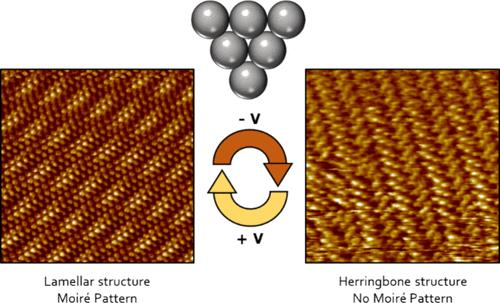Voltage-Gated Switching of Moiré Patterns in Epitaxial Molecular Crystals
IF 15.8
1区 材料科学
Q1 CHEMISTRY, MULTIDISCIPLINARY
引用次数: 0
Abstract
Studying molecular materials at the nanoscale allows us to gain a deeper understanding of supramolecular structure formation and serves as the basis for rationally controlling the resulting interfacial properties. Here, we describe the formation of extended Moiré patterns resulting from the assembly of dipolar π-conjugated molecules on highly oriented pyrolytic graphite at the liquid–solid interface as characterized by scanning tunneling microscopy (STM). By switching the bias of the sample and thus the orientation of the external electric field in the vicinity of the STM junction, structural reorganization of the molecular building blocks and the resulting organic 2D crystal is induced and can conveniently be monitored in situ by the appearance and disappearance of the Moiré patterns. Importantly, the formation and loss of the Moiré patterns are fully reversible, providing exquisite control over epitaxial molecular crystals. Our approach provides fundamental insights into the supramolecular organization and resulting superstructure formation of incommensurable 2D lattices upon applying an electric field and enables the rational tuning of Moiré patterns as a key step toward the potential integration of organic 2D crystals in molecular nanodevices.

外延分子晶体摩尔纹的电压门控切换
在纳米尺度上研究分子材料能让我们更深入地了解超分子结构的形成,并为合理控制由此产生的界面特性奠定基础。在这里,我们描述了双极性π共轭分子在液固界面高度定向的热解石墨上组装所形成的扩展莫伊里纹,这是以扫描隧道显微镜(STM)为特征的。通过改变样品的偏置,进而改变 STM 交界处附近外部电场的取向,可诱导分子构件和由此产生的有机二维晶体的结构重组,并可通过莫伊里纹的出现和消失方便地进行现场监测。重要的是,摩尔纹的形成和消失是完全可逆的,从而提供了对外延分子晶体的精妙控制。我们的方法从根本上揭示了在施加电场时超分子组织和由此形成的不可比二维晶格的超结构,并实现了对莫伊里耶图案的合理调节,这是实现有机二维晶体与分子纳米器件潜在集成的关键一步。
本文章由计算机程序翻译,如有差异,请以英文原文为准。
求助全文
约1分钟内获得全文
求助全文
来源期刊

ACS Nano
工程技术-材料科学:综合
CiteScore
26.00
自引率
4.10%
发文量
1627
审稿时长
1.7 months
期刊介绍:
ACS Nano, published monthly, serves as an international forum for comprehensive articles on nanoscience and nanotechnology research at the intersections of chemistry, biology, materials science, physics, and engineering. The journal fosters communication among scientists in these communities, facilitating collaboration, new research opportunities, and advancements through discoveries. ACS Nano covers synthesis, assembly, characterization, theory, and simulation of nanostructures, nanobiotechnology, nanofabrication, methods and tools for nanoscience and nanotechnology, and self- and directed-assembly. Alongside original research articles, it offers thorough reviews, perspectives on cutting-edge research, and discussions envisioning the future of nanoscience and nanotechnology.
 求助内容:
求助内容: 应助结果提醒方式:
应助结果提醒方式:


